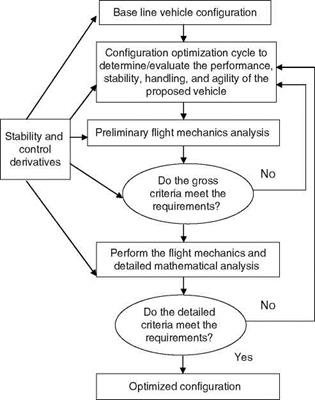ROLE OF DERIVATIVES IN AIRCRAFT DESIGN CYCLE AND FLIGHT CONTROL LAW DEVELOPMENT
Aerodynamic derivatives play a very important role in the selection of the configuration to meet performance, agility, and maneuverability of the vehicle [4]. Some design criteria that a typical fighter aircraft is expected to comply with to realize the acceptable stability and control performance characteristics are discussed next. The stability and control derivatives provide significant inputs to the design process.
Some derivative related criteria:
Common criterion for stable/unstable configurations: Cn = 0.13/rad up to high AOA. Also at CL max, Cn should be equal/greater than Cn at zero AOA.
Criterion for stable configuration: the damping ratio of the SP should be between 0.35 and 1.3. It must be recalled that SP damping is very closely dependent
on Cmq.
Criterion for unstable configuration: for absolute sideslip up to 15° pitch up should not be present, i. e., Cmft < 0.
The lateral-directional derivatives are not influenced by longitudinal instability. However, the change in pitching moment due to change in AOSS (Cm ) plays an important role in the design cycle of unstable configuration. If it has a positive value, then it signifies the pitch up at moderate AOSS and can affect the Cm and Cm derivatives. Thus Cmft should be zero or negative up to ±15° of AOSS. In Figure 4.3 we see that there are certain criteria termed as gross and detailed criteria that are required to be met to obtain the final configuration of the vehicle. Gross criteria are based on the expert designer’s feel translated to some numerical values of the
|
|
derivatives that the configuration should possess. Once these criteria are satisfied, one proceeds to meet the detailed criteria. Some compound derivatives, as discussed in Section 4.3.3, based on basic derivatives are to be met in the gross criteria. The positive values of these compound derivatives are needed to ensure departure-free dynamic behavior of the aircraft up to maximum AOA. The detailed criteria need detailed mathematical analysis or simulation of dynamics to further ascertain their compliance. The derivatives play an indirect role in this process as they appear in TFs. These studies are also vital in the assessment of the stability and control characteristics of the aircraft, for which flight control laws need to be developed, especially for the inherently unstable configuration. The derivatives form important inputs to the control law development process and are also necessary to determine air loads on the vehicle. The study of aerodynamic derivatives is also important to assess the effect of changes in aircraft configurations (air brakes, slates, leading edge vortex control devices, etc.) and assessment of stores (like missiles, drop tanks, etc.). A further role of stability derivatives is in realizing the combat effectiveness of any fighter aircraft. The combat effectiveness is a function of
(a) Performance: sustained turn rate, specific excess power, and level speeds
(b) Agility: ability to change the state vector in the shortest possible time
(c) Maneuverability: roll performance, pullup, and roll pull out
(d) Operational boundaries: AOA-AOSS envelope restricted by recovery margins, lateral-directional divergence angles, and pitch up
The primary dependence of these on stability derivatives is qualitatively presented in Table 4.10. From the foregoing discussions we see that aerodynamic derivatives, often called stability and control derivatives or in short, stability derivatives (and often only as derivatives), play a very crucial role in aircraft design cycles, performance optimization, design and development of flight control laws, flight simulation, and many related analyses of aircraft (missiles) from flight mechanics point of view. We see that the information and knowledge from control and system theories play
TABLE 4.10
 |
||||
Relation of Derivatives to the Combat Effectiveness of a Typical Fighter Aircraft
![]() Cm. , Cn. , CL
Cm. , Cn. , CL
![]() Singh, K. P. and Sreenivasan, M. N., Aerodynamic stability derivatives, Personal communications and notes, Hindustan Aeronautics Limited, Bangalore, 1990. With permission.
Singh, K. P. and Sreenivasan, M. N., Aerodynamic stability derivatives, Personal communications and notes, Hindustan Aeronautics Limited, Bangalore, 1990. With permission.
Besides the usual role these derivatives play.
an important role in the task of understanding and appreciating this design and development process apart from flight mechanics modeling and analysis.












